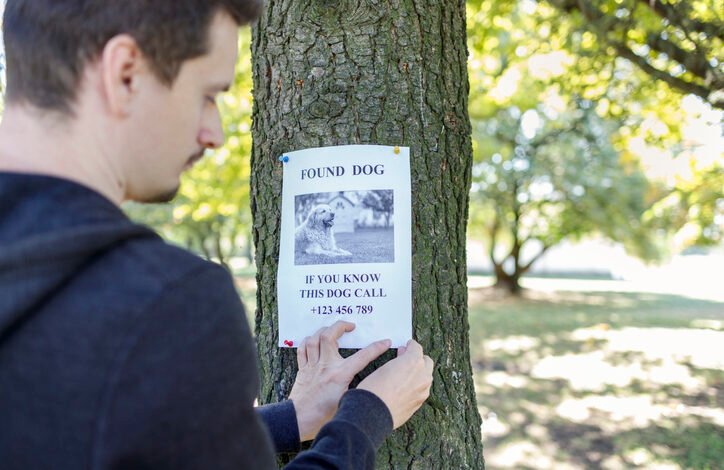
Are you one of the good Samaritans who stopped to pick up a dog you found running along a roadway, or offered the stray dog who has been spotted running around your neighborhood a square meal and a safe place to sleep? And now that he’s been saved from the street, you’re wondering who to call about that stray dog, and where you can take him?
Wonder no longer. Here are the steps you should take after you have found a lost dog:
- Bring him to your local animal shelter to be scanned for a microchip, to check for a “lost dog” report, and to file a “found dog” report. If you are not sure where the correct shelter is located, call the closest veterinary hospital; they will always know where local strays should be taken.
In the best-case scenario, he’s in possession of a registered identification microchip, and a quick scan at the shelter gives the staff the information they need to quickly reunite the dog and his owner. Yay! If he has no microchip, however, or the one he has is not registered with current contact information for the owner (Boo!), then someone – either you or the shelter staff – will have to do some detective work, to see if the owner can be found.
Most shelters maintain a log of “lost dog” and “found dog” reports. At my local shelter, they allow people to look through the log themselves – and they try to make matches when someone at the front counter has time, which isn’t all that often. But if someone is making an honest effort to find their lost dog, this is one of the places they will look.
If he’s a super nice dog and you don’t want to leave him at the shelter – and if you have the space and ability to keep him safe at your home – most shelters will allow you to take him home, and will forward your contact information to anyone who comes to the shelter looking for him. But be aware that sometimes, people only search their shelter websites for pictures of their lost dogs, and if the dog is not at the shelter, his picture will not appear on the shelter website. Only an owner who comes to the shelter and looks through the found dog reports will learn that you have the dog. The odds of being reunited with his owner are better if he’s at the shelter than anywhere else.
But if you live in an area where unclaimed stray dogs get euthanized fairly quickly, and you have the ability to securely house and feed the dog, by all means, let the shelter know that you will care for him while you add the following steps to your “to do” list
- Use social media to advertise the dog, and ask all your friends who are online to share the post. Take a good, clear photo of the dog and post a description on your own social media (make sure your posts are public, so they can be shared widely) and on the pages of any animal-welfare sites in your area. In my area, there are Facebook groups with names like “Oroville Lost and Found Pets” (serving my town), Butte County Lost/Found Animals (serving my county), “530 Lost and Found Pets” (serving a several-country area served by the 530 area code). Search for the term “lost and found pets” on Facebook and you should find several for your area. You can also ask other dog owners you know if they are aware of other groups like this. Nextdoor.com is another site where posts like this can be widely shared.
Be aware that some of these groups require people to be a “member” of the group before they can post, so there might be a delay of a day or two between finding the groups and being able to post in them. Post a good photo, describe the dog, and include your phone number.
Don’t forget about craigslist.org: You can post a description of the found dog there, too. Not long ago, the roommate of a friend accidentally allowed my friend’s dog to escape the house when my friend was not home. Dozens of his friends quickly shared his “lost dog” posts on Facebook, but he received a call from someone he knew who saw a “found dog” post on craigslist.org that sounded like it was about his dog (and it was). The finders were an older couple who eschew social media. Hedge your bets and post in every forum you can!
- Make some “Found Dog” signs. There are lots of people who don’t have a computer or use social media. Posting some “Found Dog” fliers in well-trafficked areas near where the dog was found will reach those people. Use a big, clear photo and a large font with your phone number – preferably so large that it can be read from a passing car. Or, you can make a larger poster without a photo but briefly describing the dog, such as, “Found: Large black male dog, short tail.” That’s enough for someone who has lost their dog to recognize the possibility the dog you have might be theirs. Try to post them at major intersections within a mile or three of where the dog was found.
It’s also helpful to distribute fliers to local veterinary clinics, pet supply stores, groomers, and other animal-related businesses that have a bulletin board or other location for fliers.
Should you find the dog a nice home with someone you know?
I think you can answer this question by asking yourself whether you would want this outcome if your dog went astray. Say you were on vacation for two weeks and your dog got away from the dog walker or neighborhood kid you hired to care for your dog while you were gone. Someone found the dog, but because they didn’t get a response to their found-dog posts or the report at the shelter, they assumed the dog had been “dumped” and gave the dog to their brother-in-law (or someone else). That person, your dog’s new owner, might never be aware that “your” dog is very much loved and missed and wanted.
If you fall in love with the dog, and are tempted to keep him yourself, just keep in mind that there can be any number of reasons why a person may be unable to search for their beloved dog, or see and respond to “found dog” ads. There was just an article in the Washington Post about a man who was in the hospital, with a friend taking care of his little dog. His condition worsened, and his doctors put him into a medically induced coma for over three weeks. Sometime after he was reawakened, his friend came to tell him the sad news that his dog had run away weeks before. The dog had been picked up and taken to a shelter, where, after being unclaimed for weeks, he was put up for adoption – and was adopted by a person who fostered him for the shelter.
Fortunately, an intermediary who was familiar with the shelter connected the adopter and the dog’s original owner, and acted as an intermediary to convince the new owner that the little dog really did belong with his original owner, who lost the dog through no fault of his own. But the media is full of stories like this with more contentious endings, where the new owners won’t give up their newly adopted dog, and the shelter is unable to legally intervene.
It’s best if you can host the dog yourself while continuing to share occasional found-dog posts, at least for a couple months, before determining that no one is out there still looking for their dog. Ask your local shelter staff what the law in your state requires before you can consider a “found dog” your own, and when sufficient time has passed, get the dog licensed in your name and get microchipped – and make sure you register it as soon as possible.




